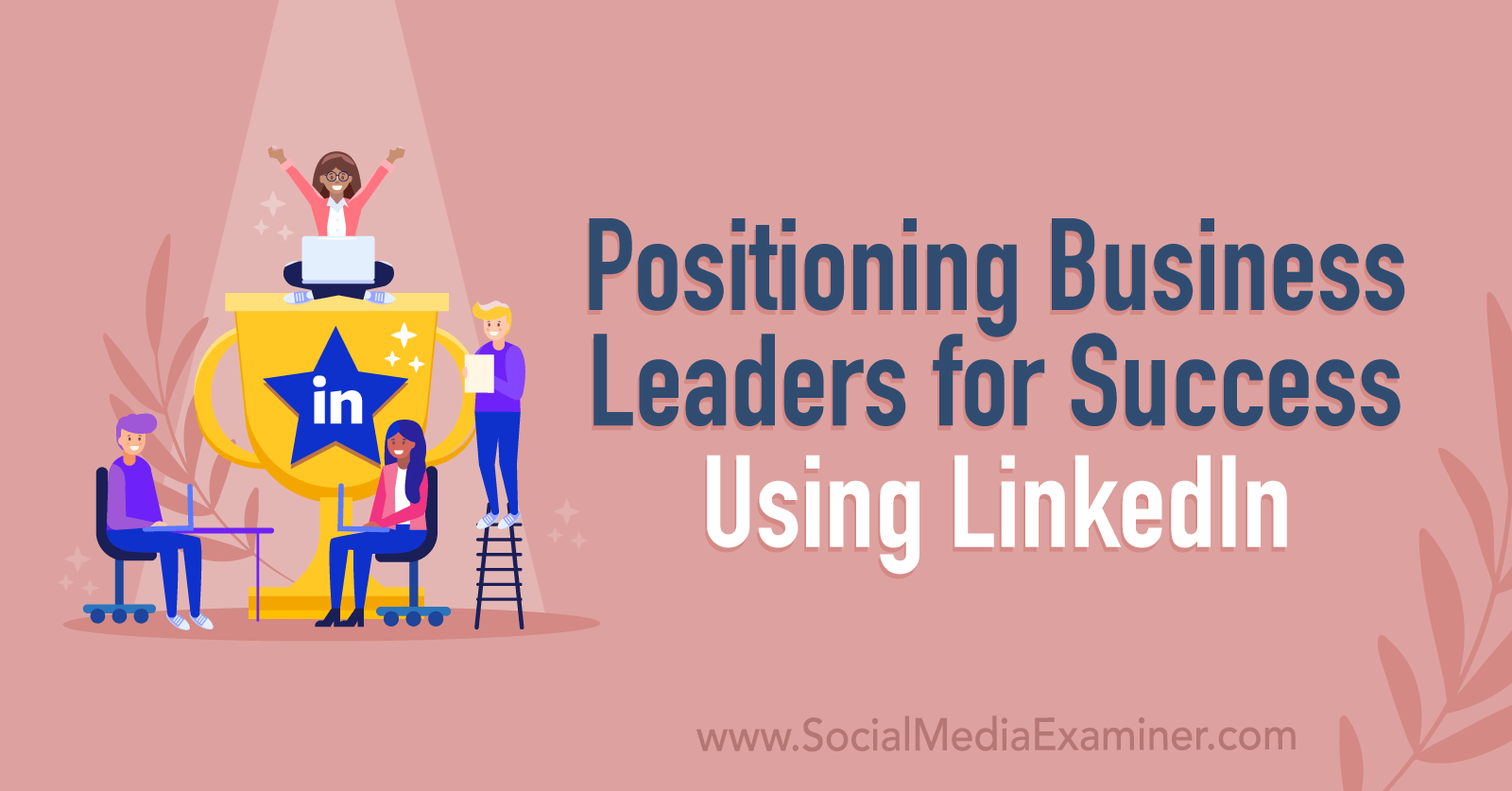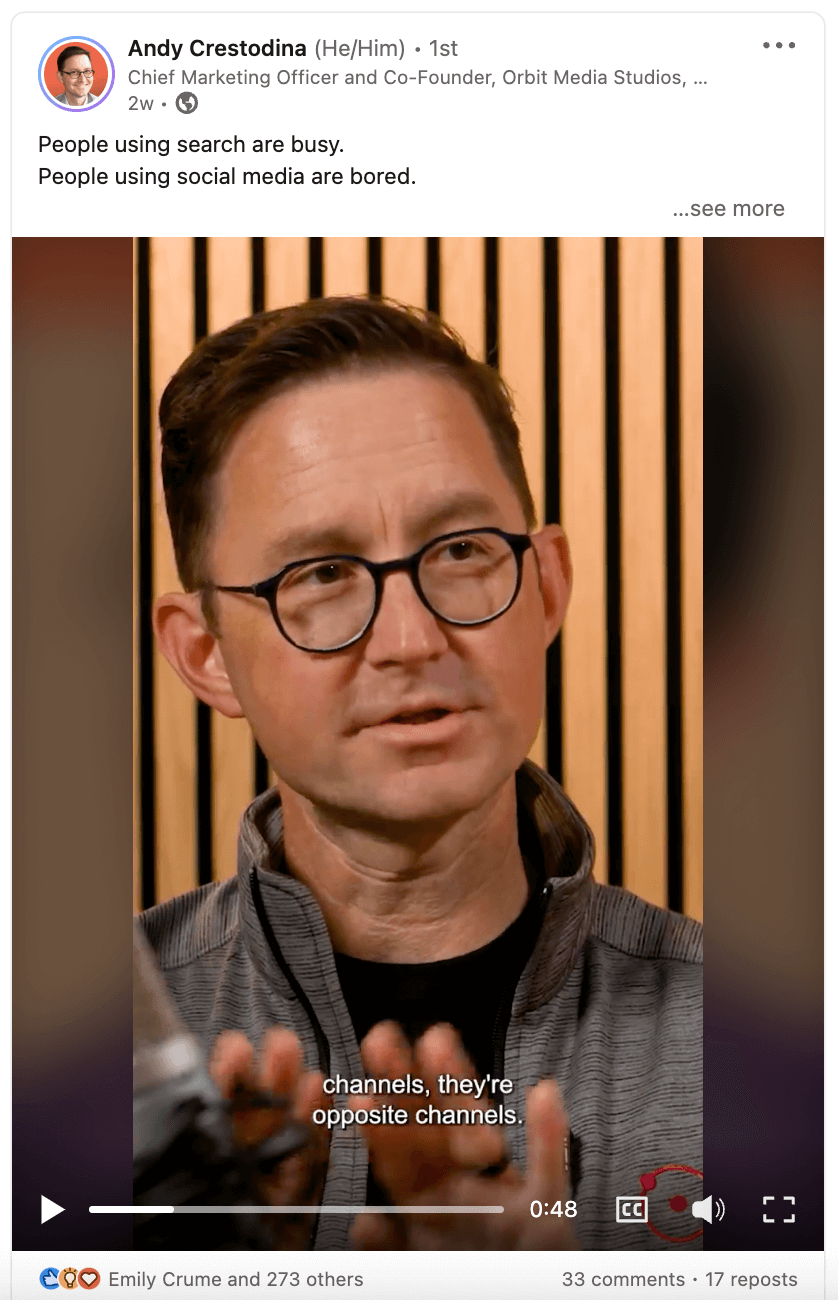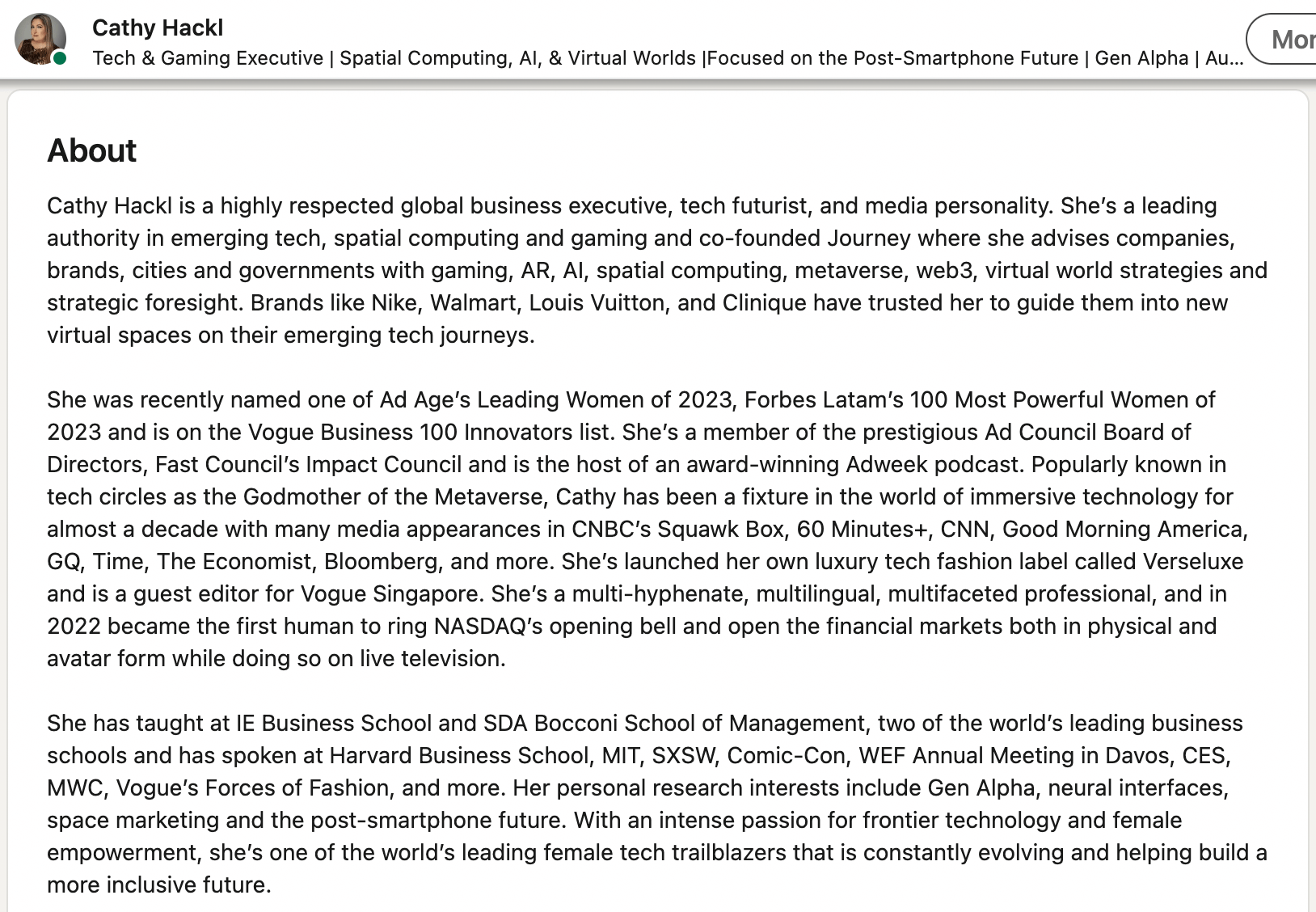Want to leverage the reputation of your company’s leadership on LinkedIn? Wondering what types of content your owner or CEO can write about?
In this article, we’ll explore how to position leaders to take advantage of LinkedIn.

Why Should Business Leaders Focus on LinkedIn?
A business leader or executive is the number one marketing asset any company has. When they speak on stage in front of an audience, people and marketing teams listen—they want to know more. Business leaders are also the number one salesperson in their company—they explain the value of their company and how it fits into a particular industry. Finding a way to contribute to relevant conversations happening online in real-time as an executive is critical.
This is why LinkedIn is an indispensable platform for any business leader.
You never know who might come across your content on LinkedIn and want to connect with you or your company. Actively engaging on LinkedIn can attract opportunities for you—It could lead to lucrative partnerships, investments, or new business. And as a business leader, you are in a position to take advantage of these opportunities.
By regularly publishing insightful content, you demonstrate your knowledge and thought leadership—you become an accessible public face for your company and extend your brand reach when you share your perspectives and insights on LinkedIn.

This credibility enables you to speak out effectively during crises or major events impacting your industry. Let’s say you’re the CEO of a security company and it got hacked. The narrative around this incident is bad. But because you already established a track record of regularly speaking out on LinkedIn you are able to take control back of the narrative.
Additionally, as an active executive on LinkedIn you can attract top talent and meet key audiences. Professionals looking to take a job at your company are going to want to see who’s leading that company. Sure, they can go to your company’s website and look at the leadership, but they’re only seeing the sanitized good stuff—very carefully synthesized marketing speak.
Think of it this way, if you are a business leader looking to hire a VP of Sales, for example, you’ll jump on LinkedIn to see how a potential candidate is already performing in your industry. That potential candidate is also reviewing your profile to see how you are leading your company. There are strong indications that employees are not as confident in their leadership if the leadership isn't demonstrating confidence or competence online.
Essentially, all of your customers, partners, employees, and vendors are on LinkedIn—it’s where the money is. An engaging LinkedIn presence conveys your competence and confidence to these people—it humanizes you as a business leader. And as a leader, you must have a presence on platforms where your audiences are active.
#1: Busting 3 Common Myths About LinkedIn
What stops you from posting on LinkedIn? You know that it delivers value, but you are resistant to spending your time on the platform. Here are three common misperceptions about LinkedIn to consider:
Myth 1: LinkedIn is a Time-Suck
Like many leaders, you may point to social media addiction and complain you don't have time for LinkedIn. You see your employees, your children, and a variety of influencers living their lives on social media, but you have a whole company to run. However, maintaining an engaging presence online does not require an excessive time commitment from you. Your team can create a plan and process to implement social media efficiently that requires the minimum amount of time and attention from you.
Myth 2: It's All About Self-Promotion
Get World-Class Marketing Training — All Year Long!
Are you facing doubt, uncertainty, or overwhelm? The Social Media Marketing Society can help.
Each month, you’ll receive training from trusted marketing experts, covering everything from AI to organic social marketing. When you join, you’ll also get immediate access to:
- A library of 100+ marketing trainings
- A community of like-minded marketers
- Monthly online community meetups
- Relevant news and trends updates
As a business leader, you are probably really good at lifting up your teammates. So, actively promoting yourself online may seem antithetical to your leadership style. Again, you may see sports stars, politicians, and influencers on social media and think it’s all about them all of the time. Positioning LinkedIn not as self-promotion but as an opportunity for you to build a brand of authenticity will allow you to connect with your customers and help your organization.
Myth 3: You Have Nothing Valuable to Contribute
Even accomplished CEOs often downplay whether there is interest in their ideas—imposter syndrome is real! Your audience may not want to know what you had for breakfast, but they certainly want to know your ideas about your industry and organization. Remind yourself of the insights and stories you share behind the scenes that would resonate more widely with your audiences if they were published on LinkedIn.
#2: Optimizing Your LinkedIn Profile
Your LinkedIn profile is likely the first impression people will have of you online. As a business leader, it's important that your profile properly conveys your professional stature and brand.
Banner Image
First, start with your banner image. This is a chance for you to visually establish your brand. Select a visually impactful, high-quality image. It could showcase your industry, geography, events, or passions—just don't add text!. You shouldn't add phone numbers, websites, calls to action, and value propositions. These things aren’t clickable, copyable, saveable, or actionable. And oftentimes you can't even read them on a mobile device.
Instead, use your banner as a way to visually identify something that ties you to your customers, industry, and company like your organization’s logo, for example. You can even use a personal image and overlay your company’s logo in the upper right corner. Be sure not to put your logo in the left corner or middle of the banner image because your headshot will cover it up.

If you’re a public speaker, use an image of yourself on stage. If you're a leader trying to identify some strength of influence, show an image of yourself at an event. Maybe you’re passionate about cycling, rock climbing, or your local dog rescue. Use an image that captures your passions while still identifying and tying in your brand.
Maybe you’re on a yacht off the coast of Mazatlan, and you snap a photo on your boat. Organic photos are a great branding opportunity as well. If you’re stuck trying to come up with a banner image, use a shot of your university’s campus. It shows your pride in your alma mater even if your audience may not recognize the Greek columns from Stanford University or Notre Dame, for example.
Headshot
Second, focus on your headshot. Use an updated, high-resolution professional headshot cropped closely on your face with your nose in the center. Even if you’re camera shy, avoid casual photos or group shots like your marriage photo, for example. Sure, you look good, but you still need to think about how you’re presenting yourself to your audience. You don’t want to lose a seven-figure deal, for example, because your profile doesn’t look professional.
Headline or Bio
Next, create your headline. Summarize your value proposition, role, and company in the 120 available characters. Put your key info first before any slogans.
While it’s tempting to fall back on “I help customers do this… “ it’s important to note what you do, who you do it for, and maybe where you do it. Your headline is valuable real estate that helps identify you and your company to potential customers.
Are you the CEO or founder of your company? Do you host a podcast? Are you the author of several books? These bits of information allow your audience to identify and learn a little more about you—they help your customers know where you fit into their ecosystem.
Note: when someone searches for you on LinkedIn only about 40 characters or so of your headline show up. So, make sure your company and role are up front. Then, you can put your value proposition at the end.
About Section
Rather than a general resume summary, craft a forward-looking, client-focused “about” section conveying your vision, experience, and unique value.

If you’ve been in a particular industry or role for a long time, you want to be aware that you're not labeling yourself as out of touch by listing your years of experience. Maybe you’ve been in tech for 20 years and you’re looking to switch roles. A prospective employer is going to naturally wonder if you can keep up. Or maybe you are fresh out of college—your prospective employer will wonder if you have enough experience.

Discover Proven Marketing Strategies and Tips
Want to go even deeper with your marketing? Check out the Social Media Marketing Podcast! Publishing weekly since 2012, the Social Media Marketing Podcast helps you navigate the constantly changing marketing jungle, with expert interviews from marketing pros.
But don’t let the name fool you. This show is about a lot more than just social media marketing. With over 600 episodes and millions of downloads each year, this show has been a trusted source for marketers for well over a decade.
Let’s suppose you’ve been in the tech industry for 25 years. In your “about” section you can say, “In my career, from Y2K to 9/11 to Cloud computing, AI, and the virtual data centers of today, I've helped my customers and the companies I have led change and negotiate through the dynamic impacts of the industry.” You’ve just sewn a small story together for your clients that shows your experience and your unique value—it helps establish your track record.
You want to make sure you identify your experience and how it applies to your relationships moving forward with the people who are looking at your LinkedIn profile, i.e. your employees, customers, partners, vendors, etc.
Sure you can add some skills, but you want to avoid leading with that—you should lead with a narrative. You’re saying, if you come to work with me, this is what’s going to happen. And it’s not that you’re going to sell anything—you’re creating a relationship based on mutual interest.
Note: you should also avoid the cliche “Once upon a time” narrative. Your audience doesn't care.
Featured Section
This is where you can feature published articles, podcast episodes, awards, or other content demonstrating your thought leadership.
Company Pages
You want to ensure your logos and links connect to active company pages to avoid “broken link” indications. If you see a little gray box next to a title, for example, that’s LinkedIn’s way of telling you the link is broken.
Even if you are a solopreneur or run a very small business, you want to link an active company page. If you're a public speaker and that's your business, have a company page on LinkedIn and then make sure that the link points to it.

The red boxes you might see are an indication that an organization does not exist anymore on LinkedIn. You want to avoid any negative impact that might have on your audience's perception of you and your company.
#3: Developing an Impactful LinkedIn Content Strategy
Merely maintaining a profile on LinkedIn is not enough for you as a business leader. To fully leverage LinkedIn, you must create and share original content consistently. This is one of the toughest things to do as a business leader.
Unfortunately, LinkedIn’s algorithm doesn't value reposted content. So, while it seems tempting to hit the repost button, know that only 1% of your audience is seeing that content. Instead, strive to create and post original content at least once a week.
Sporadic engagement won’t cut it. You should aim to become part of your audience’s feed. LinkedIn values true engagement, so even if you think posting a video and giving a teaser to your audience telling them to watch it is enough, for example, it’s not. Very seldom does a video teaser get people talking—it’s not driving any kind of engagement.
As an executive, ask yourself, “What do I actually have to say?” Your content will not go viral on LinkedIn—that is not the goal. The point is to create and share meaningful content that resonates with your target audience. As a business leader, you have a vision of what’s coming—access to pieces of data, information that may not be obvious to your audience.

This is where your marketing team or your mastermind group can help you. You’re likely caught up in the information flow and are putting out fires all while trying to run your company. So, don’t be afraid to ask for help. Be mindful though that oftentimes your team might not always know how you think. They might be able to offer you some prompts, but you need to be able to find ways to share your voice authentically.
Here are some tips to help you create original, thoughtful content as a business leader on LinkedIn:
- Comment on trends. Share your insights on industry trends and emerging issues. Tie them to strategic considerations.
- Share leadership principles. Tap into your experience to discuss valuable leadership, management, and business philosophy lessons.
- Extract lessons from books. Summarize key concepts from the books you're reading and relate them to business leadership.
- Discuss provocative topics. Don't shy away from controversy. Weigh in thoughtfully on things like AI, remote work, inclusion, etc.
- Open up about challenges. Oftentimes leaders feel they have to be the smartest person in the room—they have to have all the answers. But being vulnerable, curious, and honest can elicit engagement. Ask open-ended questions to your audience.
- Leverage AI tools. Use AI tools like ChatGPT to generate ideas and content starters. Let's say you’re teaching your daughter how to drive. Prompt ChatGPT to “Explain teaching a child to drive and tie that to having my team take risks.” Then edit the response into your own voice. Remember, your inability to master a 21st-century communication tool calls into question your ability to lead a 21st-century organization.
You can also share job openings in your company. The number one recruiter in any company is the CEO. Saying something like “I can’t wait to have you join our team because you’re the perfect candidate… Here’s the link to apply” is going to get people’s attention. While it’s important to write about your company sometimes, you don’t always have to. You don’t want to be Ned Ryerson in Groundhog Day selling insurance.
As a business leader, your online presence is the most critical component of your brand, not just for you, but for the success and future of your company as you move forward.
Richard Bliss is founder of BlissPoint, a consultancy that helps executives master LinkedIn to reach a wider audience. He is the author of Digital First Leadership: Master Social Media, Build Online Presence, and Lead Your Tribe. His podcast is called Digital First Leadership. Richard is also the creator of BlissBot, an AI tool that allows you to chat with an AI version of him. You can find him on LinkedIn. Get a free LinkedIn PDF here.
Other Notes From This Episode
- Connect with Michael Stelzner @Stelzner on Instagram and @Mike_Stelzner on Twitter.
- Watch this interview and other exclusive content from Social Media Examiner on YouTube.
Listen to the Podcast Now
This article is sourced from the Social Media Marketing Podcast, a top marketing podcast. Listen or subscribe below.
Where to subscribe: Apple Podcasts | Spotify | YouTube Music | YouTube | Amazon Music | RSS
✋🏽 If you enjoyed this episode of the Social Media Marketing podcast, please head over to Apple Podcasts, leave a rating, write a review, and subscribe.
Stay Up-to-Date: Get New Marketing Articles Delivered to You!
Don't miss out on upcoming social media marketing insights and strategies! Sign up to receive notifications when we publish new articles on Social Media Examiner. Our expertly crafted content will help you stay ahead of the curve and drive results for your business. Click the link below to sign up now and receive our annual report!
Attention Agency Owners, Brand Marketers, and Consultants

Introducing the Marketing Agency Show–our newest podcast designed to explore the struggles of agency marketers.
Join show host and agency owner, Brooke Sellas, as she interviews agency marketers and digs deep into their biggest challenges. Explore topics like navigating rough economic times, leveraging AI, service diversification, client acquisition, and much more.
Just pull up your favorite podcast app, search for Marketing Agency Show and start listening. Or click the button below for more information.

